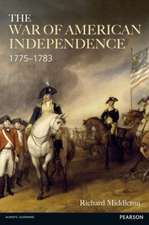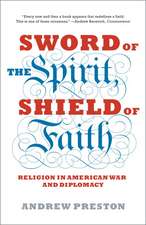The Routledge Handbook of American Military and Diplomatic History: 1865 to the Present
Editat de Christos Frentzos, Antonio S. Thompsonen Limba Engleză Paperback – 6 feb 2017
With authoritative and vividly written chapters by both leading scholars and new talent, maps and illustrations, and lists of further readings, this state-of-the-field handbook will be a go-to reference for every American history scholar's bookshelf.
| Toate formatele și edițiile | Preț | Express |
|---|---|---|
| Paperback (1) | 880.46 lei 6-8 săpt. | |
| Taylor & Francis – 6 feb 2017 | 880.46 lei 6-8 săpt. | |
| Hardback (1) | 1245.41 lei 6-8 săpt. | |
| Taylor & Francis – 21 iun 2013 | 1245.41 lei 6-8 săpt. |
Preț: 880.46 lei
Preț vechi: 1181.02 lei
-25% Nou
Puncte Express: 1321
Preț estimativ în valută:
168.47€ • 176.53$ • 139.28£
168.47€ • 176.53$ • 139.28£
Carte tipărită la comandă
Livrare economică 12-26 aprilie
Preluare comenzi: 021 569.72.76
Specificații
ISBN-13: 9781138042865
ISBN-10: 1138042862
Pagini: 416
Dimensiuni: 174 x 246 mm
Greutate: 0.73 kg
Ediția:1
Editura: Taylor & Francis
Colecția Routledge
Locul publicării:Oxford, United Kingdom
ISBN-10: 1138042862
Pagini: 416
Dimensiuni: 174 x 246 mm
Greutate: 0.73 kg
Ediția:1
Editura: Taylor & Francis
Colecția Routledge
Locul publicării:Oxford, United Kingdom
Public țintă
Postgraduate and UndergraduateNotă biografică
Christos G. Frentzos is Associate Professor of History at Austin Peay State University.
Antonio S. Thompson Associate Professor of History at Austin Peay State University.
Antonio S. Thompson Associate Professor of History at Austin Peay State University.
Cuprins
Chapter 01 Introduction, Antonio S. Thompson, Christos G. Frentzos; Part 1 Post-Civil War American Expansion at Home and Abroad; Chapter 02 Westward Expansion and U.S. Overseas Empire: 1865–1898, Anne Paulet; Chapter 03 Buffalo Soldiers on the Western Frontier, Brian G. Shellum; Chapter 04 U.S. Overseas Expansion in the Post-Civil War Era, Stephen McCullough; Part 02 The Spanish–American War and U.S. Overseas Expansion; Chapter 05 The Spanish–American War and the Development of U.S. Imperialism, Thomas Schoonover; Chapter 06 The Philippine–American War and the Birth of U.S. Colonialism in Asia, Frank Schumacher; Chapter 07 The Platt Amendment and U.S. Occupation Policies in Latin America, Cyrus Veeser; Part 03 The First World War and its Aftermath; Chapter 08 The United States in the First World War and the Treaty of Versailles: 1914–1919, Justus D. Doenecke; Chapter 09 Allied Coalition Warfare During the First World War, Brian Neumann; Chapter 10 Native American Soldiers in World War I, Thomas A. Britten; Chapter 11 Woodrow Wilson’s Fourteen Points and the League of Nations, Ross A. Kennedy; Part 04 America Between the World Wars; Chapter 12 The United States During the Interwar Years, Kenneth Weisbrode; Chapter 13 The Age of Disengagement and Disarmament, Benjamin D. Rhodes; Chapter 14 U.S. Military Planning During the Interwar Period, Lon Strauss; Part 05 America and the Second World War; Chapter 15 The United States in the Second World War, Gerhard L. Weinberg; Chapter 16 Roosevelt, Churchill, Stalin, and the Second Front, James D. Perry; Chapter 17 The Atomic Bombing of Japan, Robert Buzzanco; Chapter 18 American Women in World War II, Kara Dixon Vuic; Chapter 19 The Housing of Axis Prisoners of War in the U.S. During World War II, Antonio S. Thompson; Part 06 The United States and the Early Cold War; Chapter 20 The Origins of the Cold War at Home and Abroad, Günter Bischof; Chapter 21 The Soviet Union, the United States and Eastern Europe: 1941–1953, Laszlo Borhi; Chapter 22 U.S. Occupation Policy and Nation Building in Germany and Japan, James F. Dobbins; Chapter 23 The Cold War at Home, K.A. Cuordileone; Part 07 The Korean War and its Aftermath; Chapter 24 The Korean War, 1950–1953, James I. Matray; Chapter 25 UN Coalition Warfare During the Korean War, Jeffrey Grey; Chapter 26 Warfare and Nation Building in the Republic of Korea: 1953–1973, Christos G. Frentzos; Part 08 The Vietnam War; Chapter 27 The Vietnam War, 1945–1975, George C. Herring; Chapter 28 The Myth of an American Attrition Strategy in the Vietnam War, Gregory A. Daddis; Chapter 29 “Shaky as All Hell”, James M. Carter; Chapter 30 The Soldier’s Experience in Vietnam, Ron Milam; Part 09 U.S. Clandestine Operations and the Cold War on the Periphery; Chapter 31 The Cold War on the Periphery: 1953–1989, Michael J. SullivanIII; Chapter 32 Eisenhower, Kennedy, and the CIA, Joe Renouard; Chapter 33 U.S. Clandestine Operations in Chile, Lubna Z. Qureshi; Chapter 34 U.S. Troops as an Instrument in Foreign Policy, Kyle Longley; Part 10 America and Post Cold War Interventions; Chapter 35 Post Cold War Conflicts, Sean N. Kalic; Chapter 36 Operation Just Cause, Barry Mowell; Chapter 37 The Participation of American Servicewomen in Operation Desert Storm, Emerald M. Archer; Chapter 38 U.S. Troops in Non-Traditional Roles, Keith Pomakoy; Part 11 September 11, 2001 and its Aftermath; Chapter 39 September 11, 2001 and the War on Terror, Martin Loicano; Chapter 40 Operation Enduring Freedom, Kevin W. Farrell; Chapter 41 Operation Iraqi Freedom, Alexander Alderson;
Recenzii
The Routledge Handbook of American Military and Diplomatic History is clear, up-to-date, wideranging and interesting. The melding of military and diplomatic history works very well and the book deserves widespread attention.
– Jeremy Black, author of Introduction to Global Military History
This excellent, well-edited volume combines clearly told narratives of U.S. foreign and military policies, from the post-Civil-War era to the 21st-century invasions of Afghanistan and Iraq, with informed discussions of the evolving scholarship through which informed Americans viewed the 150 years when they moved from conquering a continent to trying to reshape large parts of the world. It deserves a wide audience ranging from students and general readers, just beginning serious study of these policies, to advanced graduate students and faculty who debate, sometimes heatedly, the changing contexts and interpretations of those historic policies.
– Walter LaFeber, author of The American Age: U.S. Foreign Policy at Home and Abroad
"The editors are to be congratulated on what they have accomplished, in terms of compiling a coherent, interesting and well-written volume, not the easiest of tasks when coordinating forty contributors."
-Priscilla Roberts, University of Hong Kong in Diplomacy & Statecraft
– Jeremy Black, author of Introduction to Global Military History
This excellent, well-edited volume combines clearly told narratives of U.S. foreign and military policies, from the post-Civil-War era to the 21st-century invasions of Afghanistan and Iraq, with informed discussions of the evolving scholarship through which informed Americans viewed the 150 years when they moved from conquering a continent to trying to reshape large parts of the world. It deserves a wide audience ranging from students and general readers, just beginning serious study of these policies, to advanced graduate students and faculty who debate, sometimes heatedly, the changing contexts and interpretations of those historic policies.
– Walter LaFeber, author of The American Age: U.S. Foreign Policy at Home and Abroad
"The editors are to be congratulated on what they have accomplished, in terms of compiling a coherent, interesting and well-written volume, not the easiest of tasks when coordinating forty contributors."
-Priscilla Roberts, University of Hong Kong in Diplomacy & Statecraft
Descriere
The Routledge Handbook of U.S. Military and Diplomatic History provides a comprehensive analysis of the major events, conflicts, and personalities that have defined and shaped the military history of the United States in the modern period. Each chapter begins with a brief introductory essay that provides context for the topical essays that follow by providing a concise narrative of the period, highlighting some of the scholarly debates and interpretive schools of thought as well as the current state of the academic field. Starting after the Civil War, the chapters chronicle America's rise toward empire, first at home and then overseas, culminating in September 11, 2001 and the War on Terror.
With authoritative and vividly written chapters by both leading scholars and new talent, maps and illustrations, and lists of further readings, this state-of-the-field handbook will be a go-to reference for every American history scholar's bookshelf.
With authoritative and vividly written chapters by both leading scholars and new talent, maps and illustrations, and lists of further readings, this state-of-the-field handbook will be a go-to reference for every American history scholar's bookshelf.














